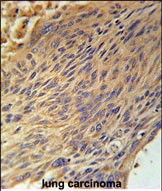CPEB4 Antibody (N-term)
Affinity Purified Rabbit Polyclonal Antibody (Pab)
- 产品详情
- 文献引用 : 1
- 实验流程
- 背景知识
Application
| WB, IHC-P, E |
|---|---|
| Primary Accession | Q17RY0 |
| Other Accession | NP_085130.2 |
| Reactivity | Human, Mouse |
| Host | Rabbit |
| Clonality | Polyclonal |
| Isotype | Rabbit IgG |
| Calculated MW | 80152 Da |
| Antigen Region | 109-137 aa |
| Gene ID | 80315 |
|---|---|
| Other Names | Cytoplasmic polyadenylation element-binding protein 4, CPE-BP4, CPE-binding protein 4, hCPEB-4, CPEB4, KIAA1673 |
| Target/Specificity | This CPEB4 antibody is generated from rabbits immunized with a KLH conjugated synthetic peptide between 109-137 amino acids from the N-terminal region of human CPEB4. |
| Dilution | WB~~1:1000 IHC-P~~1:100~500 E~~Use at an assay dependent concentration. |
| Format | Purified polyclonal antibody supplied in PBS with 0.09% (W/V) sodium azide. This antibody is purified through a protein A column, followed by peptide affinity purification. |
| Storage | Maintain refrigerated at 2-8°C for up to 2 weeks. For long term storage store at -20°C in small aliquots to prevent freeze-thaw cycles. |
| Precautions | CPEB4 Antibody (N-term) is for research use only and not for use in diagnostic or therapeutic procedures. |
| Name | CPEB4 |
|---|---|
| Synonyms | KIAA1673 |
| Function | Sequence-specific RNA-binding protein that binds to the cytoplasmic polyadenylation element (CPE), an uridine-rich sequence element (consensus sequence 5'-UUUUUAU-3') within the mRNA 3'-UTR (PubMed:24990967). RNA binding results in a clear conformational change analogous to the Venus fly trap mechanism (PubMed:24990967). Regulates activation of unfolded protein response (UPR) in the process of adaptation to ER stress in liver, by maintaining translation of CPE- regulated mRNAs in conditions in which global protein synthesis is inhibited (By similarity). Required for cell cycle progression, specifically for cytokinesis and chromosomal segregation (PubMed:26398195). Plays a role as an oncogene promoting tumor growth and progression by positively regulating translation of t-plasminogen activator/PLAT (PubMed:22138752). Stimulates proliferation of melanocytes (PubMed:27857118). In contrast to CPEB1 and CPEB3, does not play role in synaptic plasticity, learning and memory (By similarity). |
| Cellular Location | Cytoplasm {ECO:0000250|UniProtKB:Q7TN98}. Cell projection, dendrite {ECO:0000250|UniProtKB:Q7TN98}. Cell projection, dendritic spine {ECO:0000250|UniProtKB:Q7TN98}. Postsynaptic density {ECO:0000250|UniProtKB:Q7TN98}. Cell projection, axon {ECO:0000250|UniProtKB:Q7TN98}. Cell projection, growth cone {ECO:0000250|UniProtKB:Q7TN98}. Endoplasmic reticulum {ECO:0000250|UniProtKB:Q7TN98}. Cytoplasm, perinuclear region {ECO:0000250|UniProtKB:Q7TN98} |
| Tissue Location | Expressed in pancreas in islets and ductal cells (at protein level) (PubMed:22138752). Expressed in melanocytes (PubMed:27857118). |
Research Areas
For Research Use Only. Not For Use In Diagnostic Procedures.

Application Protocols
Provided below are standard protocols that you may find useful for product applications.
BACKGROUND
There are 3 named isoforms produced by alternative splicing.
REFERENCES
Kurihara, Y., et al. Biol. Reprod. 69(1):261-268(2003)
终于等到您。ABCEPTA(百远生物)抗体产品。
点击下方“我要评价 ”按钮提交您的反馈信息,您的反馈和评价是我们最宝贵的财富之一,
我们将在1-3个工作日内处理您的反馈信息。
如有疑问,联系:0512-88856768 tech-china@abcepta.com.






















 癌症的基本特征包括细胞增殖、血管生成、迁移、凋亡逃避机制和细胞永生等。找到癌症发生过程中这些通路的关键标记物和对应的抗体用于检测至关重要。
癌症的基本特征包括细胞增殖、血管生成、迁移、凋亡逃避机制和细胞永生等。找到癌症发生过程中这些通路的关键标记物和对应的抗体用于检测至关重要。 为您推荐一个泛素化位点预测神器——泛素化分析工具,可以为您的蛋白的泛素化位点作出预测和评分。
为您推荐一个泛素化位点预测神器——泛素化分析工具,可以为您的蛋白的泛素化位点作出预测和评分。 细胞自噬受体图形绘图工具为你的蛋白的细胞受体结合位点作出预测和评分,识别结合到自噬通路中的蛋白是非常重要的,便于让我们理解自噬在正常生理、病理过程中的作用,如发育、细胞分化、神经退化性疾病、压力条件下、感染和癌症。
细胞自噬受体图形绘图工具为你的蛋白的细胞受体结合位点作出预测和评分,识别结合到自噬通路中的蛋白是非常重要的,便于让我们理解自噬在正常生理、病理过程中的作用,如发育、细胞分化、神经退化性疾病、压力条件下、感染和癌症。








